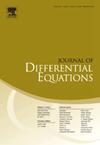Constructive approaches to QP-time-dependent KAM theory for Lagrangian tori in Hamiltonian systems
IF 2.3
2区 数学
Q1 MATHEMATICS
引用次数: 0
Abstract
In this paper, we prove a KAM theorem in a-posteriori format, using the parameterization method to look invariant tori in non-autonomous Hamiltonian systems with n degrees of freedom that depend periodically or quasi-periodically (QP) on time, with ℓ external frequencies. Such a system is described by a Hamiltonian function in the 2n-dimensional phase space, , that depends also on ℓ angles, . We take advantage of the fibered structure of the extended phase space . As a result of our approach, the parameterization of tori requires the last ℓ variables, to be precise φ, while the first 2n components are determined by an invariance equation. This reduction decreases the dimension of the problem where the unknown is a parameterization from to 2n.
We employ a quasi-Newton method, in order to prove the KAM theorem. This iterative method begins with an initial parameterization of an approximately invariant torus, meaning it approximately satisfies the invariance equation. The approximation is refined by applying corrections that reduce quadratically the invariance equation error. This process converges to a torus in a complex strip of size , provided suitable Diophantine conditions and a non-degeneracy condition on the torsion are met. Given the nature of the proof, this provides a numerical method that can be effectively implemented on a computer, the details are given in the companion paper [9]. This approach leverages precision and efficiency to compute invariant tori.
哈密顿系统中拉格朗日环面qp -时变KAM理论的构造方法
本文用参数化方法证明了具有周期或拟周期(QP)依赖于时间的n自由度非自治哈密顿系统的不变环面,证明了一个后检格式的KAM定理。这样的系统可以用2n维相空间M中的哈密顿函数来描述,这个哈密顿函数也依赖于角φ∈T我们利用了扩展相空间M×T的光纤结构。由于我们的方法,环面的参数化需要最后的r个变量,精确地说是φ,而前2n个分量由一个不变性方程决定。这种减少减少了问题的维度,其中未知是一个参数化,从2(n+ r)到2n。为了证明KAM定理,我们采用了准牛顿方法。这种迭代方法从一个近似不变环面的初始参数化开始,这意味着它近似满足不变性方程。通过应用二次减小不变性方程误差的修正来改进近似。当满足合适的丢番图(γ,τ)条件和扭转的非简并条件时,该过程收敛到ρ∞大小的复杂条带上的环面。鉴于证明的性质,这提供了一种可以在计算机上有效实现的数值方法,详细信息请参阅伴写论文[9]。该方法利用精度和效率来计算不变环面。
本文章由计算机程序翻译,如有差异,请以英文原文为准。
求助全文
约1分钟内获得全文
求助全文
来源期刊
CiteScore
4.40
自引率
8.30%
发文量
543
审稿时长
9 months
期刊介绍:
The Journal of Differential Equations is concerned with the theory and the application of differential equations. The articles published are addressed not only to mathematicians but also to those engineers, physicists, and other scientists for whom differential equations are valuable research tools.
Research Areas Include:
• Mathematical control theory
• Ordinary differential equations
• Partial differential equations
• Stochastic differential equations
• Topological dynamics
• Related topics

 求助内容:
求助内容: 应助结果提醒方式:
应助结果提醒方式:


